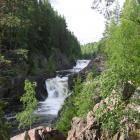The Kivach waterfall is the second-highest cascade waterfall after the Rhine Falls, and is situated on the river Suna in Karelia. The first Russian health resort, Marcial Waters—founded by Tsar Peter I in 1719—is located a few kilometers away. The Kivach waterfall is 10.7 meters high, including three additional small cascades. When the famous Russian poet Gavrila Derzhavin (1743–1816) visited Kivach in the late eighteenth century, the Suna’s “unruly stream” inspired him to write his important poem The Waterfall (1794). However, since Derzhavin’s time, both stream and waterfall have changed considerably.
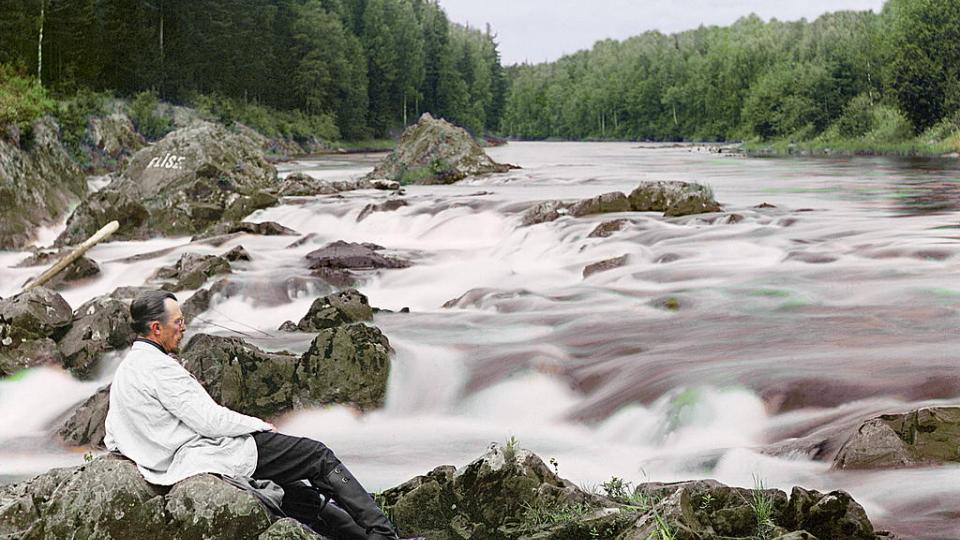
Sergey Produkin-Gorsky (a pioneer of color photography) shoots a self-portrait in front of Suna River near the Kivach waterfall (1915).
Sergey Produkin-Gorsky (a pioneer of color photography) shoots a self-portrait in front of Suna River near the Kivach waterfall (1915).
1915 photograph by Sergey Prokudin-Gorsky (1863–1944). Click here to view LOC source.
 This work is licensed under a Creative Commons Public Domain Mark 1.0 License.
This work is licensed under a Creative Commons Public Domain Mark 1.0 License.
In 1929, the Kondopoga hydroelectric power station was built and put into operation. At first, it was supplied solely with water from Lake Sandal and did not use any water from the Suna. However, in the late 1920s, a project was created to divert part of the Suna’s water to the power station in order to increase its capacity. The construction of a dam near Lake Girvas was completed in 1936; part of the water from one channel of the Suna was diverted to Lake Sandal along the specially built Pionernyi canal.
As a result, the Kondopoga hydroelectric power station was supplied with enough water to work year-round at full power. One negative consequence of the construction was that the water level further downriver decreased, so that the Kivach waterfall grew markedly shallower, and two further cascade waterfalls—the Girvas and the Poor-porog—dried up altogether.
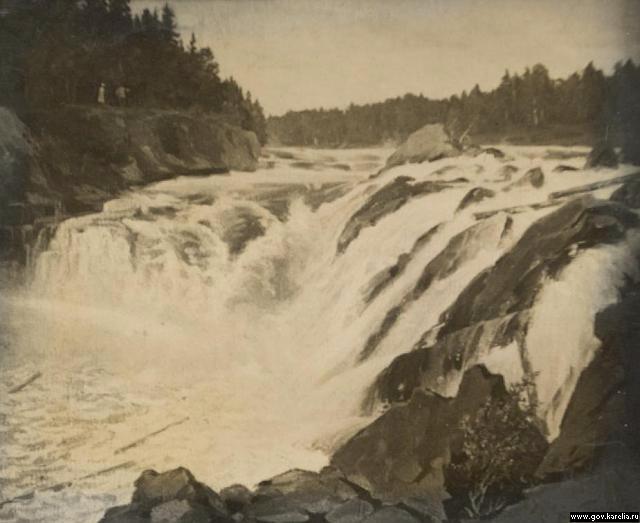
Photo of the Kivach waterfall (1912)
Photo of the Kivach waterfall (1912)
1912 by Veniamin Popov
Click here to view The Official Karelia source.
 This work is licensed under a Creative Commons Public Domain Mark 1.0 License.
This work is licensed under a Creative Commons Public Domain Mark 1.0 License.
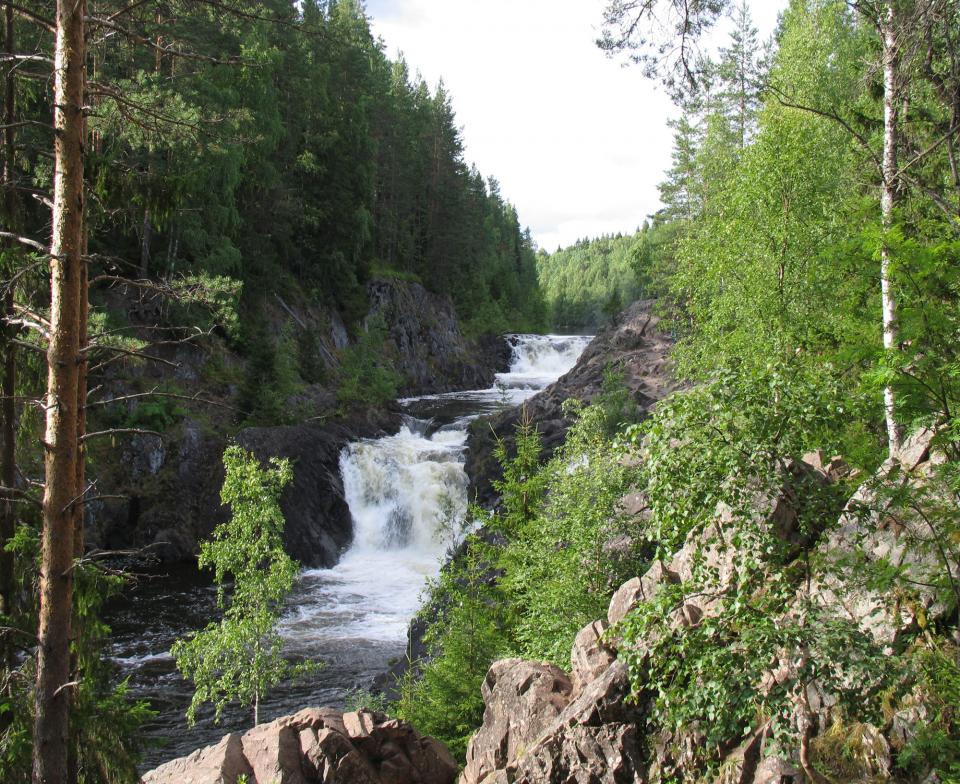
Photo of the Kivach waterfall showing the enormous transformation of stream and landscape after the construction of the Girvas dam (2008)
Photo of the Kivach waterfall showing the enormous transformation of stream and landscape after the construction of the Girvas dam (2008)
2008 wikimedia user “Mike1979Russia”
Click here to view Wikimedia source.
 This work is licensed under a Creative Commons Attribution-NonCommercial-ShareAlike 3.0 Unported License.
This work is licensed under a Creative Commons Attribution-NonCommercial-ShareAlike 3.0 Unported License.
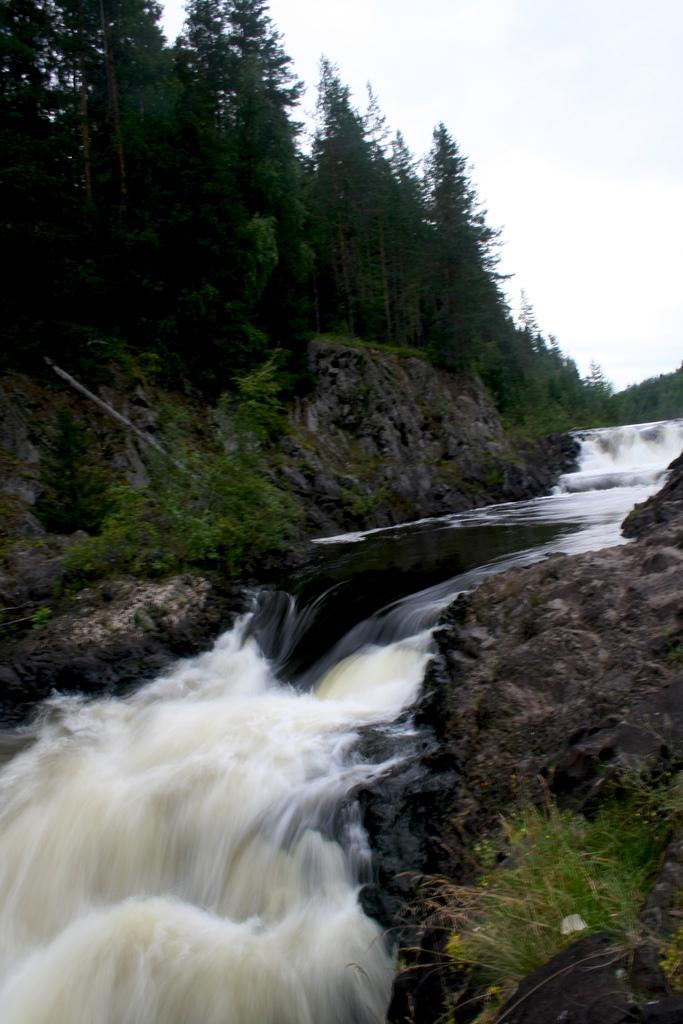
View of the Suna River and the Kivach waterfall
View of the Suna River and the Kivach waterfall
2007 Christian Toennesen
Click here to view Flickr source.
 This work is licensed under a Creative Commons Attribution-NonCommercial-ShareAlike 3.0 Unported License.
This work is licensed under a Creative Commons Attribution-NonCommercial-ShareAlike 3.0 Unported License.
The dam was built in spite of the fact that, in 1931, the eponymous Kivach nature reserve had been created with the waterfall at its center. Practical interests superseded the interests of nature conservation. The decline in the Suna’s water level was not the only negative outcome of this anthropogenic influence.
The Suna had long been used for timber rafting. For this purpose, a timber slide bypassing the waterfall was built in 1837 in order to protect the timber from falling into the cascade and becoming damaged. Rafting continued along the river even after 1931, as it had in the eighteenth and nineteenth centuries, although it was now officially part of the nature reserve. This meant that the bottom of the river channel was jammed with rotting wood, which could periodically be seen floating to the surface next to the waterfall. Only in the 1970s was timber rafting stopped and the river channel cleaned. But the magnificent appearance of the waterfall—which, until the dam was built in the mid-1930s, could compete with the Rhine Falls in terms of both beauty and power—had been lost.
How to cite
Suzi, Grigory. “Losing the Unruly Stream: Kondopoga and the Kivach Waterfall.” Environment & Society Portal, Arcadia (2013), no. 11. Rachel Carson Center for Environment and Society. https://doi.org/10.5282/rcc/5417.
ISSN 2199-3408
Environment & Society Portal, Arcadia
 This work is licensed under a Creative Commons Attribution-NonCommercial-ShareAlike 3.0 Unported License.
This work is licensed under a Creative Commons Attribution-NonCommercial-ShareAlike 3.0 Unported License.
2013 Grigory Suzi
This refers only to the text and does not include any image rights.
Please click on the images to view their individual rights status.
- Fadeeva, M. Kivach: istoriia poselka v istorii kraia. [Electronic resource in Russian]
- Skripkin, Mikhail et al. Kivach: zapovednik, vodopad. Petrozavodsk: Skandinaviia, 2007.
- Verkhogladov, V. "Mify i iav' Kivacha." In Sever 1–2 (2010): 172–91.



